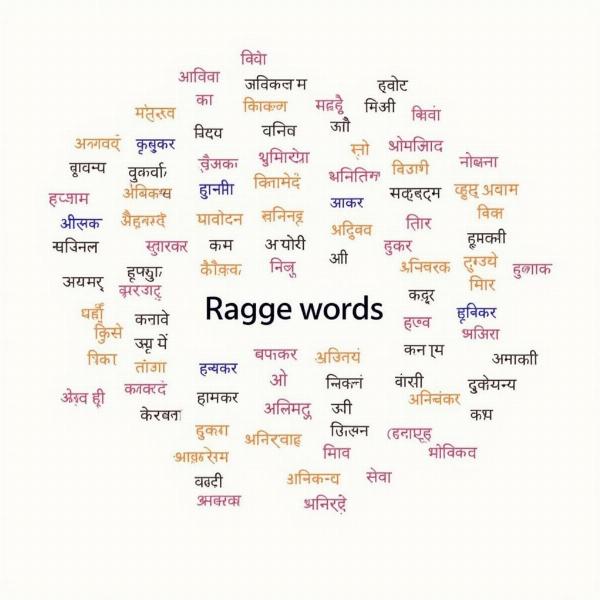Understanding the nuances of Hindi vocabulary can be challenging, especially when dealing with words like “raggedy.” This guide explores the various meanings of “raggedy” in Hindi, along with its cultural context, usage, and related terms. We’ll delve into the subtle differences between similar words, providing clear examples to enhance your understanding.
Exploring the Hindi Equivalents of “Raggedy”
“Raggedy” primarily describes something old, torn, and worn out. In Hindi, several words capture this essence, each with subtle variations in meaning. Let’s examine some of the most common translations:
-
Phata-purana (फटा-पुराना): This is perhaps the closest equivalent to “raggedy.” It directly translates to “torn and old” and describes clothes, fabrics, or other items in a state of disrepair. For instance, “He was wearing a raggedy shirt” could be translated as “Vah ek phata-purana kameez pehen raha tha (वह एक फटा-पुराना कमीज़ पहन रहा था).”
-
Fatichar (फटीचर): This word emphasizes the tattered and torn nature of something. It carries a stronger connotation of being worn out and beyond repair compared to simply “phata-purana.” Imagine a flag flapping in the wind for years; it would be described as “fatichar (फटीचर).”
-
Purana (पुराना): While simply meaning “old,” this word can imply a worn-out condition depending on the context. For example, “purane kapde (पुराने कपड़े)” can refer to old clothes, which might be raggedy depending on their state.
-
Ghisapita (घिसापिटा): This term describes something that is worn down due to extensive use, often to the point of being threadbare. It captures the idea of something being “raggedy” because it’s been used excessively.
Cultural Context and Usage
The use of these words goes beyond just describing physical objects. They can also reflect social and economic realities. In India, “raggedy” clothing might be associated with poverty or hardship. However, it can also represent simplicity and a rejection of materialistic values. The context is crucial in understanding the intended meaning.
For instance, describing a beloved old toy as “purana (पुराना)” carries a sense of nostalgia and affection, while describing someone’s clothes as “fatichar (फटीचर)” might be considered disrespectful.
Raggedy vs. Shabby: Understanding the Nuances
While both “raggedy” and “shabby” describe something worn out, there are subtle differences. “Shabby” often implies a lack of care or maintenance, while “raggedy” focuses more on the physical state of being torn and worn. In Hindi, “kharab (ख़राब)” or “bekaar (बेकार)” might be used to convey the sense of “shabby,” although they don’t fully capture the nuance.
Delving Deeper into Related Terminology
Several other Hindi words relate to the concept of “raggedy”:
-
Jirna-sheerna (जर्जर-शीर्ण): This term describes something dilapidated and decaying, often used for buildings or structures.
-
Tuta-futa (टूटा-फूटा): This describes something broken and fragmented, similar to “shattered” or “broken down.”
Common Questions about “Raggedy” in Hindi
1. What’s the most common Hindi word for “raggedy”?
- Answer: “Phata-purana (फटा-पुराना)” is the most common and versatile translation.
2. Is it offensive to use these words to describe someone’s appearance?
- Answer: Yes, it can be offensive, especially words like “fatichar (फटीचर).” Use caution and sensitivity.
3. Can “purana (पुराना)” always be used as a synonym for “raggedy”?
- Answer: No, “purana” simply means “old.” Context is essential in determining whether it implies a “raggedy” condition.
 Hindi Vocabulary Related to Raggedy
Hindi Vocabulary Related to Raggedy
Conclusion
Understanding the various Hindi words for “raggedy” allows for more nuanced communication and a deeper appreciation of the language’s richness. Remember to consider the context and choose the most appropriate word to convey your intended meaning accurately.
FAQs
- What is the literal translation of “phata-purana”?
- Answer: “Torn and old.”
- Which word emphasizes the tattered nature of something?
- Answer: “Fatichar.”
- What word describes something worn down from excessive use?
- Answer: “Ghisapita.”
- Is “raggedy” always a negative term in Hindi?
- Answer: Not always; it can also represent simplicity.
- What word is used for dilapidated buildings?
- Answer: “Jirna-sheerna.”
- What is the difference between “raggedy” and “shabby”?
- Answer: “Shabby” implies neglect, while “raggedy” focuses on physical wear and tear.
- Can “fatichar” be used to describe a person’s clothes?
- Answer: It’s best to avoid using “fatichar” to describe someone’s clothing as it could be considered offensive.
Meaning-Hindi.in is your one-stop solution for all your Hindi translation needs. We offer a wide range of professional translation services, including business and commercial document translation, certified and legal document translation, technical and user manual translation, website and localization services, educational and academic document translation, express translation, and specialized translations. Contact us today for accurate and culturally sensitive translations. Email: [email protected], Phone: +91 11-4502-7584. Meaning-Hindi.in is your trusted partner for bridging the language gap.